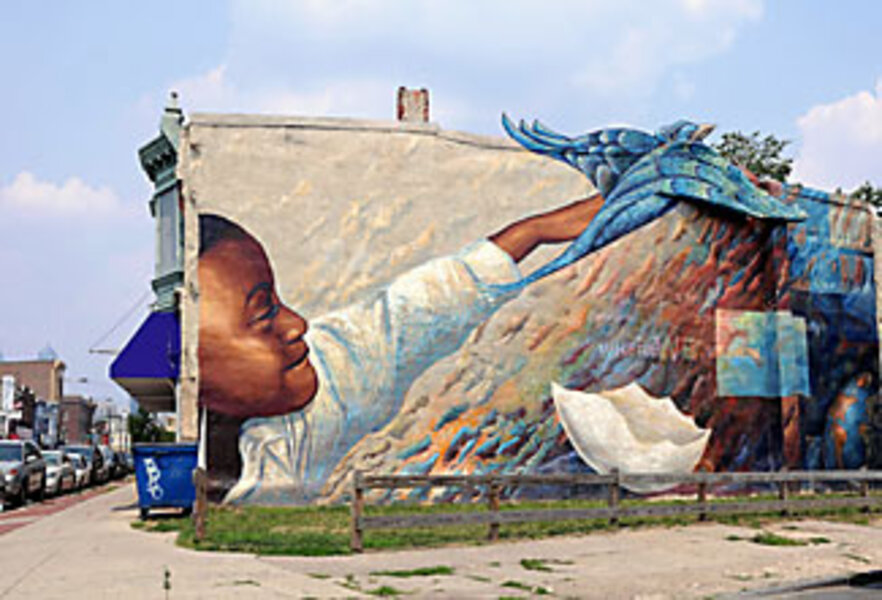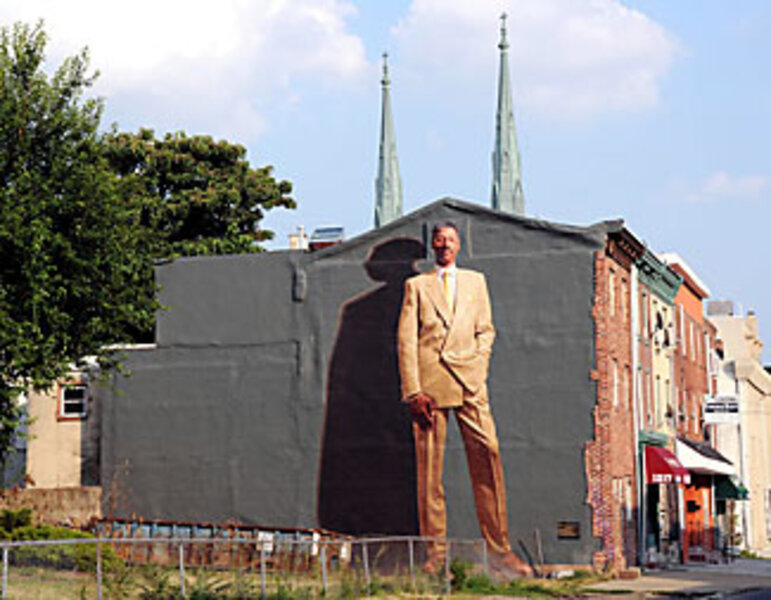Philadelphia picture show
Loading...
| Philadelphia
They rise from vacant lots in rundown neighborhoods, covering the sides of brick row houses, shuttered businesses, and even schools and community buildings, their brilliant designs emerging like wildflowers in a forgotten garden of crumbling cement and rubble.
In one, a young boy reaches for a bird, its blue wings extending beyond the building's roofline. In another, baseball great Jackie Robinson slides into home, his outstretched hand signifying not only his winning run but his breaking of the color barrier.
They tell stories of hope and redemption, of cultural traditions, of community leaders long gone. But whether it's a portrait of basketball legend Julius "Dr. J" Irving or Keith Haring's whimsical dancing figures, the images all have one thing in common: They tell the story of Philadelphia and the people who live in its poorest neighborhoods.
Philadelphia boasts more than 2,800 indoor and outdoor murals, with another 135 created annually. Next year, the city will celebrate the 25th year of the program that started as an anti-graffiti initiative and has spawned similar programs in cities such as Cleveland, Detroit, and Washington, D.C.; and in locations as far away as Paris and Hanoi, Vietnam.
"Murals represent people's stories and struggles," says Jane Golden, executive director of the Mural Arts Program (MAP), a nonprofit city agency. "Murals are a point frozen in time, when people came together to accomplish something tangible. It's something that's unique in the life of this city."
Since the 1980s, the city has been beset with skyrocketing homicide rates, racial violence, and decaying neighborhoods. For many of those early years, the city also suffered from rampant graffiti, viewed as an outward sign of the city's troubles.
In 1984, Mayor W. Wilson Goode created the Anti-Graffiti Network, of which MAP was a component. To direct the program, he hired Ms. Golden, who had worked for the Los Angeles Citywide Mural Project and felt strongly that Philadelphia's graffiti writers would enjoy creating murals.
"I was taken by their talent," she says. "Here was this interesting group of young people who have been left out of the system, sort of disconnected from the mainstream, but they seemed to have a big love of art. They also had an uncanny knowledge of abstract expressionism."
In the beginning, the murals were small corners of beauty in areas where the only visual stimulation was billboards advertising alcohol and tobacco. What happened next surprised everyone. As soon as a mural grid went up on a building, graffiti would disappear. And community members began to feel a sense of ownership of the images. One measure of the program's success is that in 25 years, only six murals have been defaced.
In addition to a network of 400 artists, MAP (www.muralarts.org) works with thousands of at-risk youth, prisoners and ex-offenders, and police officers, as well as crime victims and victims' advocates.
The key that opened the door to working with such a broad range of groups was a new method of muralmaking. In 1990, California-based muralist Kent Twitchell was brought to Philadelphia to create his "breakthrough mural" of Dr. J.
Mr. Twitchell used a synthetic rubberlike material called parachute cloth. He painted the design on squares of the cloth and then attached them to the wall using acrylic gel. This innovation allowed MAP to take murals into schools and prisons, where people who might not be able to get to neighborhood locations could still participate in the painting process.
One such mural is currently being erected on the rectory of The Church of Philadelphia. It is part of MAP's Healing Wall program, which works with the Philadelphia Prison System.
Designed by muralist Jon Laidacker and based on Renaissance painter Raphael's famous "School of Athens," it speaks to The Church of Philadelphia's mission, "Find a need and fill it. Find a hurt and heal it."
"They say that a picture is worth a thousand words," says Pastor Carmine DiBiase, "and when I saw the different murals in the city, those that have a message, I felt that we here in the church have a message for the community.
"When this mural is completed, people not only from South Philadelphia but from Center City and other parts of the city will see it and what it says," Mr. DiBiase adds. "And if they go back to their community inspired by it, that's what it's all about."
Despite the mural program's prominence, not everyone believes in its social merits. Because the murals are created predominantly in poor neighborhoods, many people still equate them with urban blight. Prosperous communities don't want the murals, and controversies have arisen over the placement of murals as well as the color of mural subjects' skin.
While troubled by the attitude of affluent neighborhoods, Golden prefers to direct her energy toward neighborhoods that want murals, and she takes comfort in changes the program makes in the lives of children who participate. Data show that 98 percent of the high school students who work with MAP graduate, a big accomplishment in a city where the dropout rate exceeds 15 percent. MAP also helps graduating students find scholarships and takes them on campus visits.
"I'm not saying that murals are a panacea for everything that ails a city," says Golden, "but it's been somewhat extraordinary for me to observe how they can promote that kind of change in a community. Someone once said to me, 'For kids who are troubled, what difference does it make if they have art?' It makes all the difference in the world.
"Do we save every kid? Of course not. No program does that. But the truth is, we save some. And that's a great thing."






